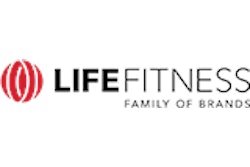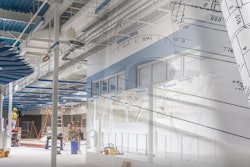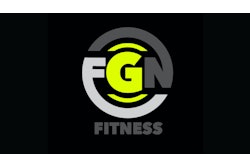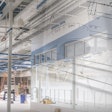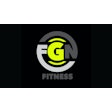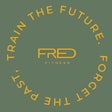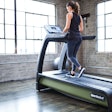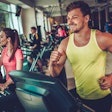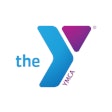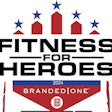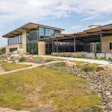As the percentage of individuals with disabilities and those with chronic illnesses continues to grow, facility operators may find that equipping their centers to serve these populations is beneficial.
Walk into any fitness facility and look at its occupants. What you will most likely see are healthy, able-bodied individuals, ranging in age from 20 to 60. But, as statistics show, these demographics don't represent those populations most in need of fitness center services: individuals with disabilities and those with chronic illnesses. There are many reasons why these populations aren't represented, stemming from both this population's perception of facilities, to the perceptions of fitness professionals about this population, and to the actions of fitness facility operators and their staff.
First is image. According to Dr. James Rimmer, director of the National Center on Physical Activity & Disability, and a professor at the University of Illinois at Chicago, "There is almost an aversion for many people with disability to use fitness clubs because the image is not tailored to what their expectations are." For instance, he explains, at fitness facilities, most people are usually lean and healthy looking. Second, Rimmer says that there is a perception by the disabled population that fitness facilities are not the place where they can have their needs met. The problem is a lack of professional training of staff to work with older adults and the disabled. This may be a consequence of the "mindset that people with disabilities are also ill and they shouldn't be exercising," says Jerry McCole, who heads the National Disability Sports Alliance.1 And last are the facilities themselves. The Americans with Disabilities Act (ADA) only scratched the surface. Rimmer says that the ADA stops at bricks and mortar. "You can get into a fitness center," says Rimmer, "but you may not have any access to [the] equipment."
The time to change these perceptions and actions is long past. With the graying of America, and the increasing size of the disabled and chronically ill population, these markets need to be served by fitness facilities of all types. And, by not serving them, facilities are sorely missing out on profits.
Those in need
As of 2004, there were 36.3 million adults ages 65 and older, and that number is expected to double to more than 71 million by the year 2030.3 The fastest growing age segment is 85-plus. Twenty-five percent of all of these older adults are members of fitness centers. While this group is more than likely independent and fit, many others are not. In fact, according to Colin Milner, CEO of the International Council on Active Aging (ICAA), Vancouver, B.C., Canada, "80 percent-plus of people 65 years old and above have at least one chronic health condition." And, yet, Milner says, many fitness centers are probably not set up to serve this population.According to the most recent U.S. Census, approximately 50 million people suffer from disabilities.2 And, the Healthy People 2010 report by the Centers for Disease Control and Prevention reports that 56 percent of people with disabilities reported no leisure-time physical activity, with only 23 percent physically active for at least 30 minutes a day three or more times a week. Much of this inactivity is likely due to a lack of a place to participate in physical activities. Indoor facilities are best suited to these individuals, "because outdoor activities such as jogging and walking ... present major barriers to individuals who are unable to perform these activities (such as people who use wheelchairs or people with balance impairment)," according to the Inclusive Fitness Coalition website.2 The result is that the disabled population has higher rates of sedentary behavior, lower levels of physical fitness and a thinner margin of health.
Milner believes that "all segments of the industry are well-positioned for growth due to the ... intense interest in mobilizing healthy lifestyles to improve quality of life while controlling healthcare costs." But, as the baby boomer generation grows older and more susceptible to disabilities, and since those with disabilities are the biggest users of medical services, those costs will continue to escalate - especially if these populations are unable to take the steps to live a healthy lifestyle. This is why fitness facility operators should be positioning themselves to serve this population - as a necessary means of preventive care.
Inclusive or exclusive?
In January 2007, the American College of Sports Medicine and the National Center on Physical Activity and Disability "began a long-term commitment to promoting 'inclusive fitness' among a broader community of citizens that includes people with disabilities and people with various activity limitations and chronic health conditions," says Rimmer. This commitment resulted in the creation of the Inclusive Fitness Coalition (IFC) to "help guide the fitness industry in recruiting new members ... [such as] people with disabilities and millions of others with chronic health conditions." Specifically, according to the IFC website (www.incfit.org), "The IFC is charged with promoting equitable access to, and safe use of, fitness and recreational equipment, facilities and programs to help reduce debilitating secondary conditions associated with disability and a sedentary lifestyle."While it's too early to tell what effect the IFC will have, it is believed by many that fitness centers are likely to come under greater regulatory pressure to provide access. According to an article on the CNN.com law center, "The U.S. Architectural and Transportation Barriers Compliance Board, an independent federal agency that develops accessibility requirements for the disabled, is promulgating regulations on sports and exercise facilities."4
The question for most facility operators is, then, how practical is it to provide access to these populations? And, is it better to be inclusive altogether, or to provide a separate space? "In many cases, apparently healthy and special populations can exercise in the same areas," says James Gallagher, general manager at Healthplex Sports Club, Springfield, Pa. Laura Neiberg, director of Good Samaritan Health & Wellness Center, Downers Grove, Ill., agrees: "I think the disabled can be 'mainstreamed' into the regular population if your layout is conducive to it." For example, she asks, does the facility have enough room for wheelchairs/walkers/canes to safely maneuver around equipment? Do participants have to transfer from the wheelchair to the equipment, or can they stay in the wheelchair and still use it? "To make a facility inclusive, make sure that all areas of the club, including the fitness equipment, are ADA-accessible," says Gallagher.
"There is no one-size-fits-all approach to this market," says Milner. "What works for one club ... may not work for another. However, in general, we have seen a massive shift to specialized clubs." Milner says that research performed by Mark Beauchamp, an assistant professor in the School of Human Kinetics at the University of British Columbia in Canada, may shed some light on the older adult trend. Milner says research found that "although older adults may report a lack of appeal for exercising with those much younger than themselves, they ... exhibit a positive preference for exercising with those of their own age." Everybody has a different spin on it, according to Rimmer: "It's really a preference of the user. I guess the question is: Should both options be available? Everybody with a disability doesn't need a specialized center. They might just need some minor adaptations."
What is agreed on is that the biggest benefit of inclusion, where all populations work out together, is that people can come together and learn from each other. "The benefit of exercising in the same area [is that it] promotes a sense of community with the healthy populations," Gallagher says. "People do not feel isolated or labeled in a mixed environment." And, let's not forget the need for motivation. At the Good Samaritan Health & Wellness Center, Neiberg says, "the disabled are actually motivating to the rest of our population - sort of the idea that 'if they can exercise with their disability, what am I whining about?'"
Accessible equipment
Many fitness centers provide access to the facility, but they lack the equipment and layout necessary to make the facility truly accessible. There are two main problems: accessibility and equipment design.Accessibility addresses everything from providing adequate passageways into and around the facility and its equipment, plus proper signage on doors and travel routes. The website for the National Center for Physical Activity and Disability (www.ncpad.org/get/fitnessCenter/index.html) provides an illustrated and interactive demonstration of ways to improve accessibility. Users can click on the image to see before and after layouts, as well as on individual pieces of equipment. Wheelchair accessibility is only one aspect, however. Facility operators also need to consider other disabilities, such as being visually impaired. For instance, it's important to keep equipment out of aisles and to notify individuals if equipment has been rearranged.
The accessibility issue may soon change. An article in the New York Times says that, "New federal guidelines for enforcing the 1990 disabilities act, now under review by the Department of Justice, would mandate that health clubs provide a clear floor space of at least 30 inches by 48 inches around each type of weight-training equipment so people in wheelchairs can get to them."5
But, as Rimmer explains, even when facilities do offer good equipment layout, some equipment is cumbersome to use. Milner puts it well when he says, "The cornerstone of a fitness and wellness center is the tools that are used to help people accomplish their goals, no matter what their level of function." For cardiovascular equipment, says the IFC website, this can range from a simple cuff, allowing someone with poor grip to hold onto a handle, to a handcycle, which enables those without the use of their legs to get a cardio workout. For strength equipment, swivel seats that allow wheelchair users access is a must. Milner also recommends recumbent machines to allow those with limited mobility to sit with outstretched legs; manual quick starts; adjustable seat positions; large, easy-to-read displays; and smaller, incremental weight increases. Machines that have braille or voice-activated consoles allow access for the blind. And, aquatics areas must have pool lifts.
"The need for specialized equipment grows each year as our facilities see older and more severely disabled populations," says Gallagher. "Manufacturers ... should design equipment that meets ADA specifications, as well as sizing for obese and older populations." The IFC, says Rimmer, is "trying to get manufacturers to work with them on how to [create] universal designs." According to the IFC website, "Universal design goes a step beyond the ADA to create an environment that is more usable by all people, not just those with a disability." Milner says that the universal design principles make the equipment desirable for older adults, and those who are overweight, new to exercise, living with disabilities or unsure how to use it - the very people who can grow the business of commercial fitness.
Is this type of equipment cost prohibitive? "The potential profits are much higher than the costs associated with gaining [these populations'] business," says Milner. Fitness equipment is replaced quite regularly in facilities, he says, so, "if you are going to buy equipment, buy equipment that will fill the needs of all functional groups."
Suppliers providing access
There are manufacturers that recognize the need to make equipment that meets the needs of all populations. Here are some that the staff at Fitness Management were aware of at the time of publication.Pulse Fitness Systems. In 1983, a couple of paraplegic individuals approached the staff at Pulse Fitness Systems, Winnipeg, Man., Canada, about a need for a place to work out, according to Helmut Kroeker, president of Pulse. Apparently, these individuals also talked to a local YMCA, and the YMCA said that if they could get the equipment developed, the Y would buy it. So, the company took on the challenge, and by 1988, it had developed a full line of upper-body equipment, which the Y purchased.
The line, called Access, includes eight pieces: chest press, shoulder press, lateral raise, pectoral fly, lat pulldown, biceps machine, row machine and triceps machine. All of the machines are designed so that the seats swing away to allow the user to lift while seated in a wheelchair. The company is currently on the fifth generation of the product line, making slight changes, says Kroeker, when they hear suggestions. "When we hear things, we look at them and we try to make a better product," Kroeker says. The usability is the best feature of the line, he explains, because individuals "don't need help to use the equipment."
The line has sold mostly to community centers in the U.S., Canada and Japan. The cost is "only slightly more expensive than conventional equipment," says Kroeker, with each unit costing less than $3,000. "Cost is not the reason for people not to have accessible equipment," says Kroeker. "It's certainly affordable for any fitness center that wants to help disabled people."
Cybex International. Cybex, Medway, Mass., developed a line of disabled-access equipment to comply with the United Kingdom's (U.K.) Inclusive Fitness Initiative (IFI). IFI requires (in order to receive government funding) that facilities place a minimum package of disabled-access equipment, which includes the following key pieces: treadmill, upright and/or recumbent cycle, upper-body ergometer, leg curl, leg extension/leg press, and upper-body multistation and/or a range of accredited upper-body resistance equipment. These pieces must be accredited by the IFI, which Cybex's are.
The current disabled-access line is part of the Cybex VR line, and is designated VR Total Access (VR-TA). Since the IFI is now in stage two of its standards development, Cybex must ensure that all new lines pass. According to Steve Suchanek, director of product management at Cybex, the VR-TA and VR3-TA lines primarily feature wheelchair access or easy transfer to leg machines. "They also include a component for the visually impaired, which speaks to type size, instruction placement and contrast for readability," he says. "This ... includes things like multiple color contrasts and embossed borders for easy recognition of the switches."
Pricing for the VR-TA and VR3-TA lines are comparable to the VR line, Suchanek says. If needed, Cybex will also provide equipment layout suggestions.
Life Fitness. While Life Fitness, Schiller Park, Ill., doesn't yet have a disabled-access line of equipment, it is in the process of developing one. According to Mike Rotz, product manager for research and licensed products, what prompted the company to go in this direction is twofold: 1) the market trend and what they see as their "customers' needs to expand their business to be more inclusive and to attract more members from all different walks of life," and 2) like Cybex, the need to make its products comply with the IFI in the U.K.
The plan is to have a select number of pieces of cardio and strength equipment "that will be IFI stage two compliant," says Rotz. The pieces will feature embossed iconography (a feature they intend to standardize across all cardio equipment) and "color contrasting points of operations, which means any place the user interfaces with the equipment," such as height and weight adjustments and lettering. The strength machines will also be accessible to wheelchair users, and they are looking into other areas of access, such as steps to access treadmills. The projected release date for the line is the first quarter of 2008.
While Rotz says the company hasn't received any inquiries about a disabled-access line of equipment from commercial fitness facility operators, it is hearing from vertical market segments, such as senior housing developments and medical rehab markets. Whichever facilities do purchase the line, they will likely be paying more, but the added cost is unknown at this time. "We're trying to keep it as affordable as possible," Rotz says. And, just as the company does now for all of its equipment sales, it will offer layout suggestions to buyers of this line, if needed. "That would just be a part of our standard offering," says Rotz.
Facilities providing access
While some fitness center operators are beginning to provide access to people with disabilities, they are still in the minority. Some fitness center chains, such as Crunch, New York Sports Club and 24 Hour Fitness, welcome guide dogs and allow aides in for no extra charge.5 Bally Total Fitness clubs have arm cycles, let Paralympic athletes train free and have even featured a disabled athlete in their ads.Other facilities have made one or two changes that make it easier for the disabled to work out. In January 2006, in Fitness Management's Innovations column (now titled Best Ideas), we reported on a light system that the staff at Liberty Fitness, Riverside, Calif., installed on its circuit stations. The lights provide deaf members visual cues, rather than the customary audio beep, to let them know when it is time to change machines. Asphalt Green, New York, N.Y., reaches out to people with disabilities with its 50-meter pool, which is equipped with wheelchair lifts. The facility also features a 7-foot-deep exercise pool with a floor that rises to ground level, and then lowers the user into the water.5
One facility that is an exemplary model of providing access to all is the Crosstrainers Fitness Forum in Clinton Township, Mich. In 2002, the facility won a Fitness Management Nova7Award in the category of Facility Design, Construction & Decoration. Christopher Grobbel, a paraplegic as a result of an auto accident, and Randell Carver opened the facility in 2001 with a goal "to create a gym where able-bodied and disabled clientele could exercise side-by-side in an environment that both motivates and promotes social inclusion." Everything in the facility is accessible - "from the elevator to the second-floor cardio area, to the nonskid flooring and wide aisles around the facility's $250,000 worth of workout equipment. Even more important, the facility's equipment can be used for general physical fitness or rehabilitation purposes." Look at the facility's website (www.crosstrainersfitness.com) for photos of its equipment layout, including its "Wheelchair Alley."
A win/win for all
Providing access to all should be looked at as a win/win for fitness centers. Kroeker says that facilities that have the Access line from Pulse Fitness Systems say it is a great marketing tool. Gallagher agrees: "Although there are many reasons to program for special populations, including serving the mission of your institution, these programs can generate a profit margin for the owner of facilities." For instance, he says, these profits can come from membership or program fees, the conversion of short-term, temporary memberships such as those for post-rehab clients to long-term memberships, and revenue from the purchase of other items in your facility, including the food, beverage and pro shops.Manufacturers also stand to gain. "By aggressively building products that include age-friendly [and disabled-friendly] features, manufacturers are well-positioned to grow sales," says Milner. While Pulse Fitness Systems has been manufacturing equipment for specialized populations for some time, Kroeker says, "sales are [becoming] more regular."
And, no question, people who are part of these special populations, and who have been seeking a place to work out for some time, would appreciate more options - options the healthy, able-bodied population has always had available to them.


















